

Balladeer's Blog. This page will take a look at old pulp heroes.

As I’ve stated on my About page I won’t be covering the obvious heroes like the Shadow, Doc Savage, etc. In keeping with my blog’s theme I’ll be looking at those forgotten pulp heroes and heroines that I feel deserve to be better known. G-8 AND HIS BATTLE ACES – Writer Robert J Hogan created the heroic American World War One pilot G-8 in 1933 when that conflict was still being called simply The World War or The Great War. G-8 and his wingmen/ Battle Aces Nippy Weston and Bull Martin battled all the supernatural and super-scientific menaces thrown at the Allied Powers by the Central Powers of Germany, Austria- Hungary and the Ottoman Muslim Turks. Heftroman. Einige deutsche Groschenromane des frühen 20.
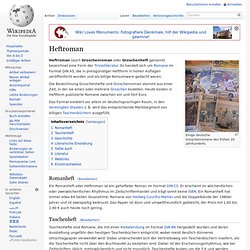
Jahrhunderts Heftroman (auch Groschenroman oder Groschenheft genannt) bezeichnet eine Form der Trivialliteratur. Es handelt sich um Romane im Format DIN A5, die in preisgünstiger Heftform in hohen Auflagen veröffentlicht wurden und als billige Konsumware gedacht waren. Die Bezeichnung Groschenhefte und Groschenroman stammt aus einer Zeit, in der sie einen oder mehrere Groschen kosteten.
Heute kosten in Heftform publizierte Romane zwischen ein und fünf Euro. Das Format existiert vor allem im deutschsprachigen Raum; in den Vereinigten Staaten z. Romanheft[Bearbeiten] Ein Romanheft oder Heftroman ist ein gehefteter Roman im Format DIN C5. Taschenheft[Bearbeiten] Taschenhefte sind Romane, die mit einer Klebebindung im Format DIN B6 hergestellt wurden und deren Ausstattung ungefähr den heutigen Taschenbüchern entspricht, wobei meist deutlich dünneres Umschlagpapier verwendet wird. Pulp-Magazin. When your next adventure was just a dime away! Magazine Data File. Argosy (Magazin) Die Argosy-Ausgabe vom 7.
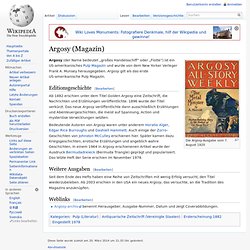
August 1920 Argosy (der Name bedeutet „großes Handelsschiff“ oder „Flotte“) ist ein US-amerikanisches Pulp Magazin und wurde von dem New Yorker Verleger Frank A. Munsey herausgegeben. Argosy gilt als das erste US-amerikanische Pulp Magazin. Ab 1882 erschien unter dem Titel Golden Argosy eine Zeitschrift, die Nachrichten und Erzählungen veröffentlichte. 1896 wurde der Titel verkürzt. Bedeutende Autoren von Argosy waren unter anderem Horatio Alger, Edgar Rice Burroughs und Dashiell Hammett. Seit dem Ende des Hefts haben eine Reihe von Zeitschriften mit wenig Erfolg versucht, den Titel wiederzubeleben.
Weird Tales. Weird Tales ist ein US-amerikanisches Pulp-Magazin, in dem Science-Fiction-, Fantasy- und Horror-Geschichten veröffentlicht werden.

Entwicklung 1923–1937[Bearbeiten] Die erste Ausgabe erschien im März 1923. Sie wurde in Chicago von J. C. Astounding. Astounding, ursprünglich Astounding Stories of Super Science, ist ein monatlich erscheinendes US-amerikanisches Science-Fiction-Magazin, das zum ersten Mal im Januar 1930 als Pulp-Magazin erschien und nach einigen Namenswechseln bis heute unter dem Namen Analog Science Fiction and Fact herausgegeben wird.

Es ist damit das langlebigste und ohne eine Unterbrechung erscheinende Science-Fiction-Magazin in den Vereinigten Staaten. Bei Fans des Genres ist es als ASF bekannt. Herausgeber[Bearbeiten] Während der ersten Jahre seines Bestehens wurde das Magazin von Harry Bates (1930–1933) und F. Orlin Tremaine (1933–1938) herausgegeben. Pulp Magazines Project. Amazing Stories. First issue of Amazing Stories, art by Frank R.
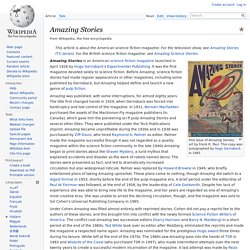
Paul. This copy was autographed by Hugo Gernsback in 1965 Amazing Stories is an American science fiction magazine launched in April 1926 by Hugo Gernsback's Experimenter Publishing. It was the first magazine devoted solely to science fiction. Doc Savage. The heroic-adventure character would go on to appear in other media, including radio, film, and comic books, with his adventures reprinted for modern-day audiences in series of paperback books.
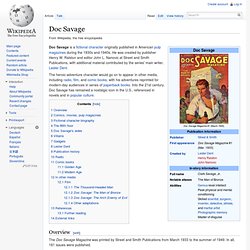
Into the 21st century, Doc Savage has remained a nostalgic icon in the U.S., referenced in novels and in popular culture. Overview[edit] The Doc Savage Magazine was printed by Street and Smith Publications from March 1933 to the summer of 1949. In all, 181 issues were published. The Shadow. "Lamont Cranston" redirects here. See The Lamont Cranston Band for the musical group. The Shadow is a collection of serialized dramas, originally in 1930s pulp novels, and then in a wide variety of media.[2] Details of the title character have varied across various media, but he is generally depicted as a crime-fighting vigilante with psychic powers posing as a "wealthy, young man about town".[2] One of the most famous adventure heroes of the twentieth century, The Shadow has been featured on the radio, in a long running pulp magazine series, in comic books, comic strips, television, serials, video games, and at least five motion pictures.
The radio drama is well-remembered for those episodes voiced by Orson Welles. Introduced as a mysterious radio narrator by David Chrisman, William Sweets, and Harry Engman Charlot for Street and Smith Publications, The Shadow was developed fully and transformed into a pop culture icon by pulp writer Walter B. Gibson. Publication history[edit] How Pulp Science Fiction Cover Art Got Its Sense of Wonder. Fu Manchu. Dr. Fu Manchu is a fictional character introduced in a series of novels by British author Sax Rohmer during the first half of the 20th century. The character was also featured extensively in cinema, television, radio, comic strips and comic books for over 90 years, and has become an archetype of the evil criminal genius while lending the name to the Fu Manchu moustache. Collection Overview - George Kelley Paperback & Pulp Fiction Collection - University at Buffalo Libraries. Pulp magazine - Bing Images. PULP-O-MIZER.
When you purchase your custom pulp magazine cover on a printed product, the reliable Pulp-O-Mizer cranks it up to high gear and - after a few seconds of groaning and sputtering - it spits out a high resolution image at (or even over) 300 pixels to the inch.
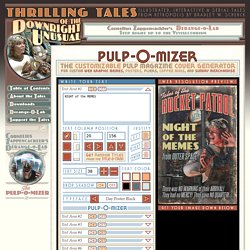
The image is immediately transmitted across the sub aetheric waves, and, well! That's when things really get interesting. We entrust your orders to well trained, electrically motivated henchmen and henchwomen. When your order arrives at our hidden facility these henchpersons burst into action: the presses fly, the hamster wheels spin, the Interociter... well... we think it interocirates, sort of, and when all's done a high quality Pulp-O-Mized product flies out of its mysterious mechanism and is swept up, before it can escape, by the unflinching claws of our own patented Ship-O-Matic. But even now, the adventure has barely begun!